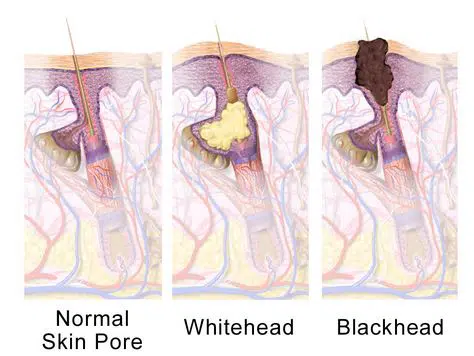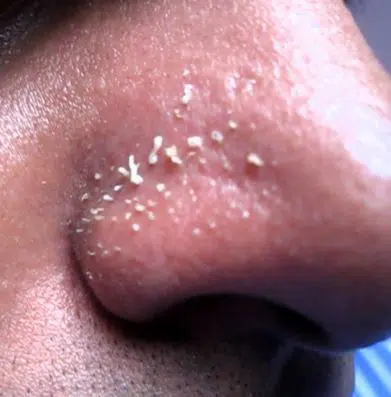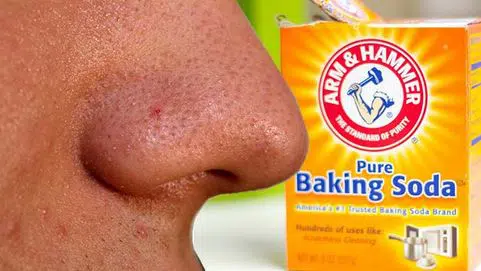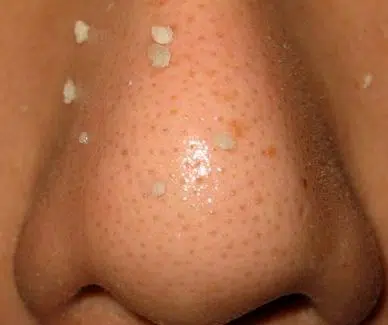What are sebaceous filaments? Where are they found and should you get rid of sebaceous filaments on nose, face, cheeks and around the mouth? Here’s a comparison between sebum gunk vs. whiteheads and blackheads on nose, and whether you should treat infected ones or squeeze them from your nose to remove them.
Definition and where sebaceous filaments are found?
What do sebaceous filaments look like? According to Wikipedia’s definition, those white things you see, mostly on your nose, are a collection of dead skin and sebum. They have a white or yellow color. Most people confuse these with whiteheads and blackheads and will apply different methods of getting rid of the filaments.
These are found naturally on the skin, usually the face is the area that is affected most. The filaments occur on the nose, all over face, on the cheeks, mostly on the chin and sometimes around the mouth, the back and even forehead. But what is the difference between sebaceous filaments and blackheads or whiteheads?
Sebaceous filaments vs. blackheads and whiteheads – the difference
Do I have blackheads or sebaceous filaments? What are those little gray dots on the nose? According to Alana Milich of The Gloss, “those little grey dots on your nose–they’re not blackheads.” The small dark dots on the nose are not always blackheads, but a rather natural skin occurrence called sebum plugs or sebaceous filaments. But what is the difference between blackheads and these sebum filaments?
- How they occur: Blackheads often occur once or in isolated places of the nose or face. Sebaceous filaments will form something like an even pattern on the oily parts of your skin, usually the nose, chin, eyebrow and forehead area and cheeks.
- Color and size: You can identify blackheads easily because they are black in color and are bigger. Oil filaments are small and smooth and appear as gray in color in most people.
- Texture: Sebum filaments are different from blackheads because they are smooth when you touch them, unlike blackheads which usually have a tough rough feel because they are raised outside the plugged pore.

Difference: blackheads vs. sebaceous filaments. Image source – Wikipedia.
When it comes to sebaceous filaments vs. whiteheads, you will notice the difference mostly in size. Whiteheads occur because of a pimple and acne breakouts. Sebaceous filaments on the nose, on the other hand, are present on every adult’s skin and are normal. See the pictures included.
Sebaceous filaments nose, chin, cheeks, around the mouth and all over face
Why are sebum filaments on the nose and all over face more visible than on other areas of the body? The skin around the nose has more secretion of sebum than any other part of the face, which is why you will see the sebaceous pores appearing to be more visible than when on the cheeks, breasts, the back, and scalp.
Should you get rid of sebaceous filaments on the nose?
No. You should not worry about how to get rid of nose sebaceous plugs or filaments because they are not blackheads. They occur because of the need to keep the skin healthy as the pores on the nose have follicles that require lubrication.
You might want to address a different problem if you do have it, like how to get rid of large pores on the nose or minimize them rather than squeezing sebaceous filaments to remove them from the nose. Squeezing the gunk out of your nose can easily lead to infected pores on the face, around the breast and cheeks.
Are they sebaceous pores and filaments or comedones on breasts, back, and forehead?
Clogged pores on the nose or clogged hair follicles on the face are often confused with the sebum filaments. Comedones are visible all over the face, on the breasts, the back, forehead and sometimes in front of the scalp. Cheeks and chin too may have filaments that may look like sebum filaments but they are comedones.
Comedones are clogged hair follicles or pores on the skin. When dirt on the skin combines with oil secreted from the pore, or sebum, it blocks the follicle. An infection can easily result from this and make you uncomfortable or try looking for treatment for sebaceous filaments if you confuse them to be so.
- When comedones are open and appear to be dark or black, they are called blackheads. They will look like dark spots on the nose.
- When they appear to be closed within the surface of the skin, they are called whiteheads. Whiteheads are often associated with acne flare-ups.
How to get rid of sebaceous filaments
Both home remedies and natural treatments can help you get rid of sebaceous plugs, clogged pores on nose and cheeks or chin. Below, we have discussed the different ways of removing, reducing and clearing the filaments and leave you with a clearer face.
Treatments, medications, manual removal of the sebum plugs, home remedies and the use of commercial pore strips, surgery, and other ways are all explained below. However, it is important to note that you cannot get rid of sebaceous filaments permanently because they are not a skin problem. You can only minimize them if they appear to be large and embarrassing.
1. Infected sebaceous filaments treatment
When sebaceous filaments get infected, they turn into blackheads. The bacteria that is left around the hair follicles can cause an infection. Treatment will be required to get rid of sebaceous filaments that are infected. Here’s are the treatments that are commonly used to clear blackheads and infected sebum plugs.
OTC medications without a prescription
Over-the-counter treatments and medications that come in the form of gels, creams, and nasal pads are available without a prescription. According to HealthLine, most of the effective treatments contain benzoyl peroxide, salicylic acid, and resorcinol.
These treatments will cure and heal infected filaments and pores by killing the bacteria present in the pores, drying up the excess oil and helping the skin to shed off dead skin cells that may clog the pores.
Prescription treatments for acne, blackheads and sebum filaments
Stronger prescription medications are used when the OTC ones fail. In most cases, the effective medical cures contain ingredients such as Vitamin A, tazarotene and tretinoin. These are good at preventing the plugs from forming in your pores around the nose.
Prescription medications also improve the shedding and growth of new skin cells, hence are good for exfoliation. Topical treatments containing benzoyl peroxide and antibiotics may also be recommended by your doctor if the infection is at an advanced stage and you have pimples on your nose.
Laser surgery for sebum filaments on the nose
Light and laser therapies are also used to remove blackheads and visible filaments. In this process:
- The surgeon will use tiny beams of concentrated light to decrease the oil secretion in your skin.
- The light is also used to kill bacteria beneath the skin.
In laser treatments, the top part of the skin is not damaged because the beam of light reaches below the epidermis of the skin.
Accutane treatments
Accutane is a drug that is known for its use as a treatment for nodular acne. It is a form of vitamin A and will help regulate the amount of oil that is being produced by the sebum glands of your skin. It also helps the skin cells renew faster, and therefore good for reducing debris of dead cells on the surface.
- Note: You should not use Accutane when pregnant. It can cause severe birth defects.
2. Sebaceous filaments removal or extraction
If you know how to remove sebaceous filaments, you can do it at home with the help of the right tools. A dermatologist can also help you remove them at the clinic. There are different methods of removing the filaments from the nose and chin area especially if they are large and visible. Here are the different ways for removing the gray dots on the nose.
Extract them with a round loop or tweezers
- A dermatologist will use a tool called a round loop to remove large filaments from the pores. This will unclog them and get rid of the blackhead that develops on the surface of the nose.
- A small opening is created with the tool or sterilized pin and then the doctor will apply gentle pressure to remove the clog of sebum and dirt.
You can also use tweezers if you are doing this at home. Blackheads and sebum plugs can be pulled out if you do it gently. Ensure the tweezers are sterilized and that you only remove the plugs that are visible, otherwise you might end up with bleeding pores on the nose.
AHA Chemical peels, BHA exfoliants and glycolic acid
Chemical peels that contain AHA (alpha hydroxyl acid) and glycolic acid will not only get rid of clogged pores but also exfoliate dead skin cells that contribute to visible gunk. Ensure you buy a mild chemical peel because the skin around the nose is sensitive.
Strong chemical solutions are used in the chemical peels to remove the top layer and open up the pores. After the treatment, you will end up with shrunken pores that appear clearer and less visible.
Squeezing sebaceous filaments to unclog pores on nose
What is the right way to squeeze blackheads and sebum plugs? While squeezing can help you get rid of the gray spots on the nose, it should be noted that this is not a permanent solution to the problem.
It is recommended that you steam them first to make them tender before trying to squeeze the filaments. When squeezing, “Push down gently, and squeeze as if you are ‘rolling up’ from underneath” [Source – Bona Fide Skin Care.]
How to make sebaceous filaments less noticeable or minimize them
Large sebum filaments can be embarrassing. Learning how to make them less noticeable or how to minimize sebaceous filaments can help you reduce their appearance. Stylecaster laments that there isn’t much one can do to get rid of these skin plugs on the nose. However, there are a few ways of reducing them with home remedies or natural treatments.
Clay mask home remedies for sebum filaments
Most clays such as Multani mitti and bentonite can absorb excess oil on the skin and help keep your pores clean and open. Dirt and oil buildup in the filaments can cause an infection, exacerbate acne flare-ups and cause the filaments to be more visible.
Make a clay face mask at least once a week to help minimize the appearance of blackheads and sebum plugs on your nose and chin.
Use mineral oil to reduce sebum filaments and blackheads
It sounds out of order to try to get rid of sebaceous filaments with more oil. But when your skin is dry, it struggles to produce a lot more oil to help keep it supple and healthy. When too much is produced, you will end up with very visible filaments.
- Apply a little mineral oil to your skin daily to satiate the need and help reduce excess sebum on the face and nose area.
- Ensure you cleanse your skin well at least once a day to get rid of any excess oil that can plug your pores and lead to whiteheads and blackheads.
Salicylic acid
According to the Huffington Post, washing your face every day and using a gentle face wash made for people with oily skin can help you get rid of sebum filaments and also blackheads. But why salicylic acid? It unclogs pores and will prevent the buildup of the sebum and the filaments.
When using salicylic acid on your face, ensure you moisturize properly because this product can dry the skin and cause cracking and many other problems.
Baking soda exfoliation
Baking soda or sodium bicarbonate exfoliates the skin. Exfoliation is important because it unclogs pores on your face and nose by removing dead skin cells and also neutralizing the skin’s pH. As a result, your skin will produce less oil, thus preventing visible filaments. Here’s how to use it to get rid of large filaments on the nose.
- Wash your face using warm water to help pores open up.
- Mix one teaspoon of baking soda and a jar of water.
- Apply the paste on the nose and affected parts of the skin.
- Allow to sit for about 3 minutes.
- Rinse it off.
- Do this twice a week.
Benzoyl peroxide cleanse remedy
Benzoyl peroxide works like salicylic acid. Here’s how to use it to get rid of sebaceous filaments on nose fast.
- Wash your face with warm water or a gentle cleanser.
- Dry your face by patting it with a towel. If you rub, you will end up bruising your face.
- Apply a small amount of benzoyl peroxide and leave to dry. Make sure the layer is just thin.
- Leave for about 3 minutes.
- Rinse it off.
- Repeat this procedure before going to bed daily to get rid of filaments and blackheads fast.
Other tips and solutions to dissolve sebaceous nose filaments
- Do facials regularly
- Toners can also help get rid of the plugs and excess oil
- Clay masks are also the best. As already discussed, bentonite and Multani mitti are some of the best clay masks to try.
- Watch your diet. If your skin is oily and dry, or acne prone, avoid fatty foods.
- You can get rid of dark spots around mouth and nose if you got scars from popping and squeezing the filaments. Try skin lightening methods to fade them naturally.
- Clarisonic and stridex treatments can also help.
- Try a coconut oil and jojoba oil cleanse.
Using pore strips to remove sebaceous nose filaments
Metafilter recommends that you use pore strips to remove those oily worms or gunk from your nose and chin. It is claimed that they work and are possibly the best possible way to get rid of the problem. So, how do these work?
When you apply pore strips on your nose, you pull out the filaments even though they will reappear in a few days. So they won’t go away forever. The main problem with these strips is that they can leave your nose a little red if you use them to remove sebaceous filaments.
Sources and references
- https://en.wikipedia.org/wiki/Sebaceous_filament
- http://www.livestrong.com/article/546911-difference-between-blackheads-sebaceous-filaments/
- http://www.bona-fide-skincare.com/squeezing-blackheads.html
- http://www.healthline.com/symptom/blackhead
- http://www.ncbi.nlm.nih.gov/pubmed/130839
- https://www.youtube.com/watch?v=2BnSSehQYvI
https://www.youtube.com/watch?v=bj2nmSdov_0




9 comments
Nice article! You should maybe update it to add some more techniques like the egg-white method like described here http://www.nose-blackheads.com do you know if these methods work for your ear aswell?
I am left with some holes on my nose after squeezing sebaceous filaments. How can i get rid of them? It is so embarassing. please answer…
Try cetaphil products in time the redness will naturally go away,don’t worry.
PSA: DO NOT TRY THE BAKING SODA REMEDY IMMEDIATELY AFTER PICKING AT YOUR FACE EVERYTHING YOU KNOW AND LOVE WILL CRUMBLE BEFORE YOUR EYES ITS BURNS OH GOD WHY
“Squeezing the gunk out of your nose can easily lead to infected pores on the face, around the breast and cheeks.”
If squeezing the gunk out of your nose leads to infected pores on your breasts, your anatomy is highly questionable.
I had great results with TCA peels. It took several strong peels ( I looked like a burn victim for 7 days each time) but pore size on my nose improved markedly and the sebaceous filaments have not recurred. I also have mild facial rosacea.
Im still not sure what to do to tighten my pores after extraction
Hi,
Oh my, those are My blackheads haha! I’ve been struggling for years, trying to remove my stubborn blackheads but I just don’t know where to start. A clinical procedure is not an option cause I would prefer a more natural approach. I’ll try some of your suggestions. Thanks for sharing!
Great article! There are simple ways you can do to get rid of sebaceous filaments, such as by not eating too much oily and fried foods that may trigger the formation of oil in your skin. Also, you should always wash your face with a gentle soap wash to keep your face less oily.